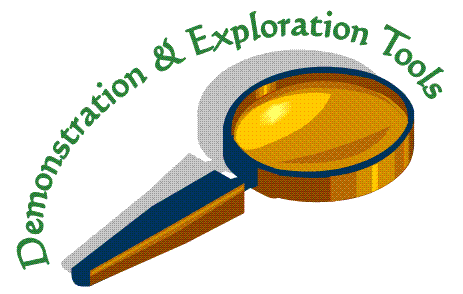Page Contents:
|
 |
| Broad Expectation* | Topic |
Link to Applet and Description
|
How good for teacher demos (1-3)?
|
How easy for students (1-3)?
|
How good for exploration (1-3)?
|
Available activities
|
| Understand numbers, ways of representing numbers, relationships among numbers, and number systems | Fractions | Fraction Pieces – Work with parts and wholes to learn about fractions. |
3
|
3
|
3
|
|
| Fractions | Fractions - Equivalent - illustrates equivalent fractions. |
3
|
3
|
2
|
built in
|
|
| Fractions | Fractions - Naming – Write the fraction corresponding to the shaded portion of a shape. |
3
|
3
|
2
|
built in
|
|
| Fractions | Fractions - Parts of a Whole – Relates parts of a whole unit to written description and fraction. |
3
|
3
|
2
|
||
| Fractions | Fractions - Visualizing – Model a fraction by dividing the shape and shading the appropriate parts. |
3
|
3
|
3 |
built in
|
|
| Decimals | Base Blocks Decimals - Model addition and subtraction of decimals. |
3
|
3
|
2
|
built in
|
|
| Decimals | Decifractator – Start with a fraction. Change the numerator or denominator and see what happens to the decimal equivalent. |
3
|
3
|
3
|
||
| Understand meanings of operations and how they relate to one another | Multiplication | Rectangle Multiplication – Visualize the multiplication of two numbers as an area. |
3
|
3
|
2
|
|
| Compute fluently and make reasonable estimate | ||||||
| Broad Expectation* | Topic |
Link to Applet and Description
|
How good for teacher demos (1-3)?
|
How easy for students (1-3)?
|
How good for exploration (1-3)?
|
Available activities
|
| Understand patterns, relations, and functions | ||||||
| Represent and analyze mathematical situations and structures using algebraic symbols | ||||||
| Use mathematical models to represent and understand quantitative relationships | ||||||
| Analyze change in various contexts | ||||||
| Broad Expectation* | Topic |
Link to Applet and Description
|
How good for teacher demos (1-3)?
|
How easy for students (1-3)?
|
How good for exploration (1-3)?
|
Available activities
|
| Analyze characteristics and properties of two- and three-dimensional geometric shapes and develop mathematical arguments about geometric relationships | ||||||
| Specify locations and describe spatial relationships using coordinate geometry and other representational systems | ||||||
| Apply transformations and use symmetry to analyze mathematical situations | ||||||
| Use visualization, spatial reasoning, and geometric modeling to solve problems | ||||||
| Broad Expectation* | Topic |
Link to Applet and Description
|
How good for teacher demos (1-3)?
|
How easy for students (1-3)?
|
How good for exploration (1-3)?
|
Available activities
|
| Understand measurable attributes of objects and the units, systems, and processes of measurement | Perimeter and Area | Cyberchase Airlines Builder Game - Drag (and sometime rotate) segments to make a spaceship. A spaceship must be an enclosed shape. Fixed perimeter. Find the shapes. |
1
|
3
|
3
|
Airline Game |
| Mass | Pan Balance: Shapes - This double pan balance provides an environment in which to consider the concept of equivalence. |
3
|
3
|
3
|
Find
the Lightest Pan Balance 2 Pan Balance 3 |
|
| Apply appropriate techniques, tools, and formulas to determine measurements | ||||||
| Broad Expectation* | Topic |
Link to Applet and Description
|
How good for teacher demos (1-3)?
|
How easy for students (1-3)?
|
How good for exploration (1-3)?
|
Available activities
|
| Formulate questions that can be addressed with data and collect, organize, and display relevant data to answer them | Graphing Data | Create a Graph Tool - for students (others) to make statistical graphs (NCES). |
3
|
2
|
3
|
|
| Select and use appropriate statistical methods to analyze data | ||||||
| Develop and evaluate inferences and predictions that are based on data | ||||||
| Understand and apply basic concepts of probability | Experimental probability | Spinners - Can make various spinners with equal or unequal regions. Spin once or multiple times. Results table provided. |
3
|
3
|
3
|
Spinner Game |
Click here for the Index for >> Online Math Games, Demonstration/Exploration Tools, and Puzzles
(This page is organized using the five content areas in school mathematics, as articulated in the NCTM Principles and Standards, 2000.)
3=Excellent for class demonstrations of mathematics
2=Fair to Good for class demonstrations of mathematics
1=Not designed for class demonstrations of mathematics
3 = No advance instruction needed (very easy to use).
2 = Short demonstration helpful (pretty easy to use).
1 = Extensive demonstration needed (hard to use without an explanation).
3=Excellent for student exploration of mathematics.
2=Fair to Good for student exploration of mathematics.
1=Not designed for student exploration of mathematics.
by: James
R. Olsen, Western Illinois University
updated:
December 14, 2011